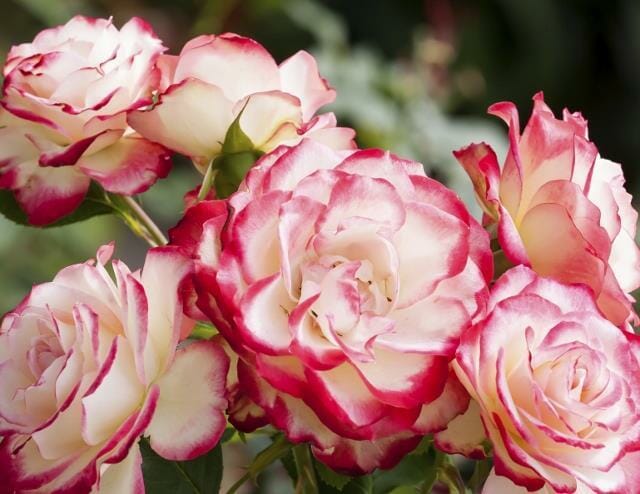
Growing Roses Successfully
Growing Roses Successfully
Dr. Leonard Perry, Extension Professor
University of Vermont
 Growing roses successfully, and for more than one season, starts with proper selection of both plants and the site. Plant properly, give sufficient water and fertilizer, and regularly watch for pests or problems as you admire these beautiful shrubs. Unless you’re a rose fancier or exhibitor, roses don’t require a great deal of care.
Growing roses successfully, and for more than one season, starts with proper selection of both plants and the site. Plant properly, give sufficient water and fertilizer, and regularly watch for pests or problems as you admire these beautiful shrubs. Unless you’re a rose fancier or exhibitor, roses don’t require a great deal of care.
Roses are one of the oldest flowers in cultivation worldwide so, as a result, there have been thousands of selections made and bred. Luckily for us, there are not so many for sale, but there are still what seems an overwhelming variety from which to choose. Perhaps the easiest starting point is to visit your local full-service nursery, and ask the trained professionals there for advice. Some of the traits to look for include flower color, time and length of bloom period, hardiness, and growth habit. Many of the newest hybrids may not be hardy in the coldest areas.
Hybrid teas, floribundas, grandifloras, miniature, and climbing roses often don’t survive well below -10 degrees (F) in winter. Neither do some series such as the David Austin roses. The popular Knock Out roses are somewhat more hardy. Of the older shrub rose groups and species, the hardiest include the gallicas, albas, centifolias, and rugosas. The Explorer series from Canada is one of the hardiest of the modern groups.
Once you choose roses, pick a suitable site in your landscape. Roses grow best in full sun (six or more hours of direct sun a day, preferably eight or more). They also need a well-drained, slightly acidic (6 to 6.5 pH) soil. Adding organic matter such as compost to the soil improves soil drainage, health and fertility. Work in a couple shovels of compost at planting, and “top dress” around plants each spring with an inch or two of compost or fine mulch. If soils are heavy, consider growing in raised beds unless in cold areas that get little snow cover. Winter soil temperatures may get too low in raised beds there.
Although early spring is generally the best time to plant roses in cold climates, potted roses may be successfully planted in late summer or early autumn as long as they are protected over winter. It’s not advisable to plant roses after the first few weeks of fall as there won’t be enough time for them to get rooted. Give plants plenty of space—generally at least three feet apart, more for the large shrub types. Often the plant label will indicate proper spacing.
To plant potted roses, dig as large a hole as possible, but at least two times as wide and across as the roots. Amend the backfill with up to half compost, peat moss, or similar organic matter. Add a tablespoon or two of phosphorus (rock phosphate is organic, superphosphate is not) depending on the size of the hole at planting. Set the plant in the hole and spread out the roots evenly. Make sure the bud graft (the lower, swollen area on most roses) is covered with at least two inches of soil.
Spring, not fall, is the time to plant bare-root roses, just as or before buds are beginning to break—usually late April or early May. Spring is, in fact, the only time you usually can get them either through mail order from specialty rose catalogs or on-line ordering on the Internet.
If planting bare root roses, mound the soil over most of the canes to help prevent buds and canes from drying out and “suckers” (unwanted shoots) from forming below the bud graft. Staking is generally not needed, but climbing types will need to be trained to travel up a wall or trellis. Don’t use fertilizer, other than the phosphorus, until bare root roses begin growing.
 It is important to keep roses well-watered, especially after planting, but they don’t survive well in waterlogged soils. Water them deeply to promote deep rooting, rather than frequent sprinkling of the soil surface. An inch or two of mulch on top helps conserve water. Water weekly unless you get an inch or more of rain in a week.
It is important to keep roses well-watered, especially after planting, but they don’t survive well in waterlogged soils. Water them deeply to promote deep rooting, rather than frequent sprinkling of the soil surface. An inch or two of mulch on top helps conserve water. Water weekly unless you get an inch or more of rain in a week.
In addition to compost, unless the soil is very fertile you will need to add rose fertilizer (check your local garden center for this product) per directions on the label. For organic fertilizers, rose growers use greensand, rock phosphate, alfalfa meal, or regular applications of seaweed or fish emulsion. Some add a tablespoon full of Epsom salts around plants in early summer for more branching. Hybrid tea roses require higher soil fertility than shrub types.
To encourage vigor, roses need to be pruned, but wait until spring as pruning in fall may cause dieback or allow diseases to enter wounds with slow, or no, healing of the wounds. You’ll also know in spring, when you see buds, what branches may be dead and need removing. During the season remove flowers when finished, and any broken or diseased branches. For the rugosa roses that form the colorful red fruit or “hips”, leave these on at the end of the season. They’re attractive, plus this signals the plant that its time to start preparing for winter.
One of the main insect pests of roses are Japanese beetles. If you have more than a few, you can knock them into a pail of soapy water. Or you can use Japanese beetle traps, but place them far away from your roses. These traps are so attractive, beetles will come from all around, munching on your roses if nearby. There are insecticides specifically labeled for rose pests and diseases. Many gardeners prefer less toxic botanical ones (derived from plants) for pests, such as those with neem or pyrethrin.
The two main diseases to watch for are powdery mildew and blackspot, both names descriptive of the symptoms. Good air circulation, or sprays (there are some organic ones such as with potassium bicarbonate) from the outset will keep the white, mildew covering off leaves. Black spots on leaves, usually during warm and wet weather, eventually cause leaves to yellow and drop off. Good air circulation, not watering overhead late in the day, growing disease resistant varieties, and removing infected leaves may provide sufficient control. Otherwise look for sprays labeled for this disease.
If you have deer roaming your neighborhood or landscape, they may find your roses tasty. If just a few plants or bed, you can protect them with deer fencing. Repellent sprays, or scents as from soap bars and human hair may be all that is needed though.
Fall-planted roses will need winter protection their first year, as do less hardy varieties every year. Mound one foot or more of loose mulch, such as straw or bark mulch, around the base if rodents aren’t a problem. Otherwise, use soil, compost, or manure. Don’t use heavy leaves (unless shredded) that will compact, keeping water and air from the soil. Apply protection late in the season, usually around Thanksgiving. Climbing roses, if not hardy, will need to be removed from the supports and laid on the ground and covered as recommended above. Mulches should be removed in the spring as soon as the snow has melted.
Roses may be grown in large containers (at least 12- to 15-inches wide) to enjoy on patios or near outdoor living spaces, or to grow less hardy varieties that you can overwinter in a sheltered, non-freezing location (as a garage). Make sure pots have drainage holes, and a well-drained soil mix (or soilless mix with some compost added) that doesn’t stay soggy when watering. Once plants are established, they will dry out more quickly in pots than in the ground, so need more attention to regular (perhaps daily) watering. Plan to repot each year into fresh potting mix.
Receive your complimentary Relocation guide and magazine


